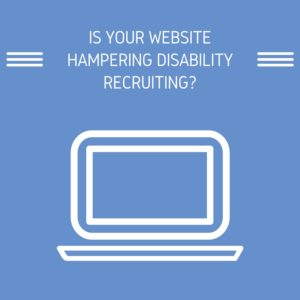The following guest post was written by Marc Zablatsky, Vice President and General Manager at Sitecues.

The importance of website usability
Usability is typically evaluated in terms of its impact on end users — their speed to complete a task, their task success rate, and their retention of information, for example. By contrast, website accessibility is generally evaluated in terms of adherence to guidelines (such as WCAG, the Web Content Accessibility Guidelines maintained by the W3C). With accessibility projects, the actual impact on end users is therefore rarely measured. By focusing on usability, organizations can better track and correct their progress toward a worthy end goal.
A focus on usability is also a way to help recruits that may fall outside of traditionally “disability” categories. Getting employees to self-identify as having a disability is a real challenge in most organizations. A related challenge is getting those employees who need help to request it. With a focus on usability rather then accessibility, accommodations can be provided to any individual who could benefit regardless of disability status or type of need. Such an approach will typically result in better support for individuals with age-related needs and with minor disabilities.
A focus on usability will help engage other parts of an internal organization in the support of People With Disabilities (PWDs). Website usability is typically the purview of User Experience and Digital Marketing groups — groups that are more rarely involved in accessibility efforts. By changing the frame from website accessibility to website usability, disability advocates will often find themselves garnering broader organizational support. Not surprisingly, disability initiatives are generally more successful when they include a broader set of organizational functions.
Common eRecruitment usability issues
A fantastic study by PEAT describes the online recruiting usability issues experienced by PWDs. Visit http://peatworks.org/content/erecruiting-accessibility-report for the full study. The complete list of issues identified in the PEAT report is long, but a subset includes:
- Complex navigation
- Poor screen contrast
- Timeout restrictions
- Fields that were mislabeled or not labeled at all
- Confusing and poorly written, and inconsistent instructions
- Lack of contact information for technical support
Interestingly, none of these issues impact only PWDs. Any recruit could face these conditions during an online application process and struggle. Eliminating the issues listed above isn’t only about supporting PWS – it’s also about delivering a good user experience. Because PWDs and the general population experience similar usability issues, fixes will generally help all users. This reality strengthens the case for taking a broad usability-centered approach, rather than maintaining a narrow focus on accessibility.
Self-assessment is the first step
With the proper focus on usability, organizations can materially improve their recruiting websites for PWDs. A good place to start is by conducting an organizational self-assessment. Below are a few questions to help start the process.
- How many of your hiring prospects struggle to use your website because of vision, learning, or language challenges?
- What are the most challenging elements of your career site and overall online application process?
- In optimizing your website user experience, what user personas do you consider? Do any of these personas include people with differing abilities?
- How much lower are your rates of online application submission for prospects with disabilities?
Few organizations will have ready answers to these questions — at least as they begin to optimize eRecruitment for PWDs. These questions are intended as conversation starters. Hopefully, the process of seeking answers will allow organizations to identify issues in their current approach and to formulate strategies for improvement.
About the author:
Marc Zablatsky is Vice President and General Manager at Sitecues. Sitecues is a division of Ai Squared, a world leader in assistive technology for over 25 years. Sitecues provides Software-as-a-Service technology that can make any website more accessible for people with diverse abilities. For more information, visit: www.sitecues.com


